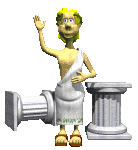| ROME |
 |
| GREECE |
| The Romans created many theaters and stadiums. One of the most notable of these is the grand Roman Colosseum located in downtown Rome. The Colosseum was the site for gladiator fights, mock naval battles in which the floor of the Colosseum was flooded, and the execution of prisoners of war and criminals. The Romans would also hang a large tarp over the seats of the Colosseum to protect the spectaters from the weather. This tarp could be put up within minutes and was was set up by sailors. In the Colosseum, there were many tiers (decks) of seats. There were seats for nobility, upper class, commoners, women, foreigners and slaves. Nobility and the rich sat closer to the floor of the arena, while commoners sat in general admission seating nearer. to the top. Women had private seating and the foreigners and slaves sat the farthest from the floor. |
| Web Master: Matt M. Assistant Web Master: Nick D. WE ALSO THANK GEOCITIES FOR HOSTING THIS WEB SITE |
| OTHER ROMAN TOPICS: |
| Bibliography: |
| Informative Links: |
| Semi-circularly shaped construction was a constant design throughout many Greek theaters. Only a few events, such as drama and orations, occurred at the Greek theater.. (Orators were public speakers) Sports events occurred in specific theaters for that purpose and the primary focus of the Greeks were their plays. Parts to the Greek theater included the diazoma(divided into two decks of seats), the orchestra (circular shaped and used to host musicians), the skene and proscenion( the building which the seats faced and which was often used to supervise special effects), the Parados (area into which actors entered, to the left and right of the procenion and skene, between the building and seats), and the koilon.(seats). |
| OTHER GREEK TOPICS: |
1. Dr. J's Illustrated Greek Drama. Dr J, web manager. <http://lilt.ilstu.edu/drjclassics/lectures/ theater/ancient_greek_theater.shtm> 2. <http://www.duraartstone.com/product %20folder/columns.html> 3. Macdonald/Bergin, Fiona/Mark. The Roman Colosseum. New York,Ny 10010:Peter Bedrick Books, 1996. 4. Jackson, James Dr. Introduction to World Humanities I. 10 Apr. 2001. <http://old.jccc.net/~jjackson/parII.html 5. New Zealand Ministry of Education.1 Aug. 2000. <http://english.unitecnology.ac.nz/resources/units/3.New /olympics/citizens-assembly.html> |
 |